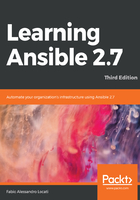
Why Ansible?
We will try and compare Ansible with Puppet and Chef during the course of this book, since many people have good experience those tools. We will also point out specifically how Ansible would solve a problem compared to Chef or Puppet.
Ansible, as well as Puppet and Chef, are declarative in nature, and are expected to move a machine to the desired state specified in the configuration. For example, in each of these tools, in order to start a service at a point in time and start it automatically on restart, you would need to write a declarative block or module; every time the tool runs on the machine, it will aspire to obtain the state defined in your playbook (Ansible), cookbook (Chef), or manifest (Puppet).
The difference in the toolset is minimal at a simple level, but as more situations arise and the complexity increases, you will start finding differences between the different toolsets. In Puppet, you do not set the order in which the tasks will be executed, and the Puppet server will decide the sequence and the parallelizations at runtime, making it easier to end up with difficult-to-debug errors. To exploit the power of Chef, you will need a good Ruby team. Your team needs to be good at the Ruby language to customize both Puppet and Chef, and there will be a bigger learning curve with both of the tools.
With Ansible, the case is different. It uses the simplicity of Chef when it comes to the order of execution – the top-to-bottom approach – and allows you to define the end state in YAML format, which makes the code extremely readable and easy for everyone, from development teams to operations teams, to pick up and make changes. In many cases, even without Ansible, operations teams are given playbook manuals to execute instructions from whenever they face issues. Ansible mimics that behavior. Do not be surprised if you end up having your project manager change the code in Ansible and check it into Git because of its simplicity!